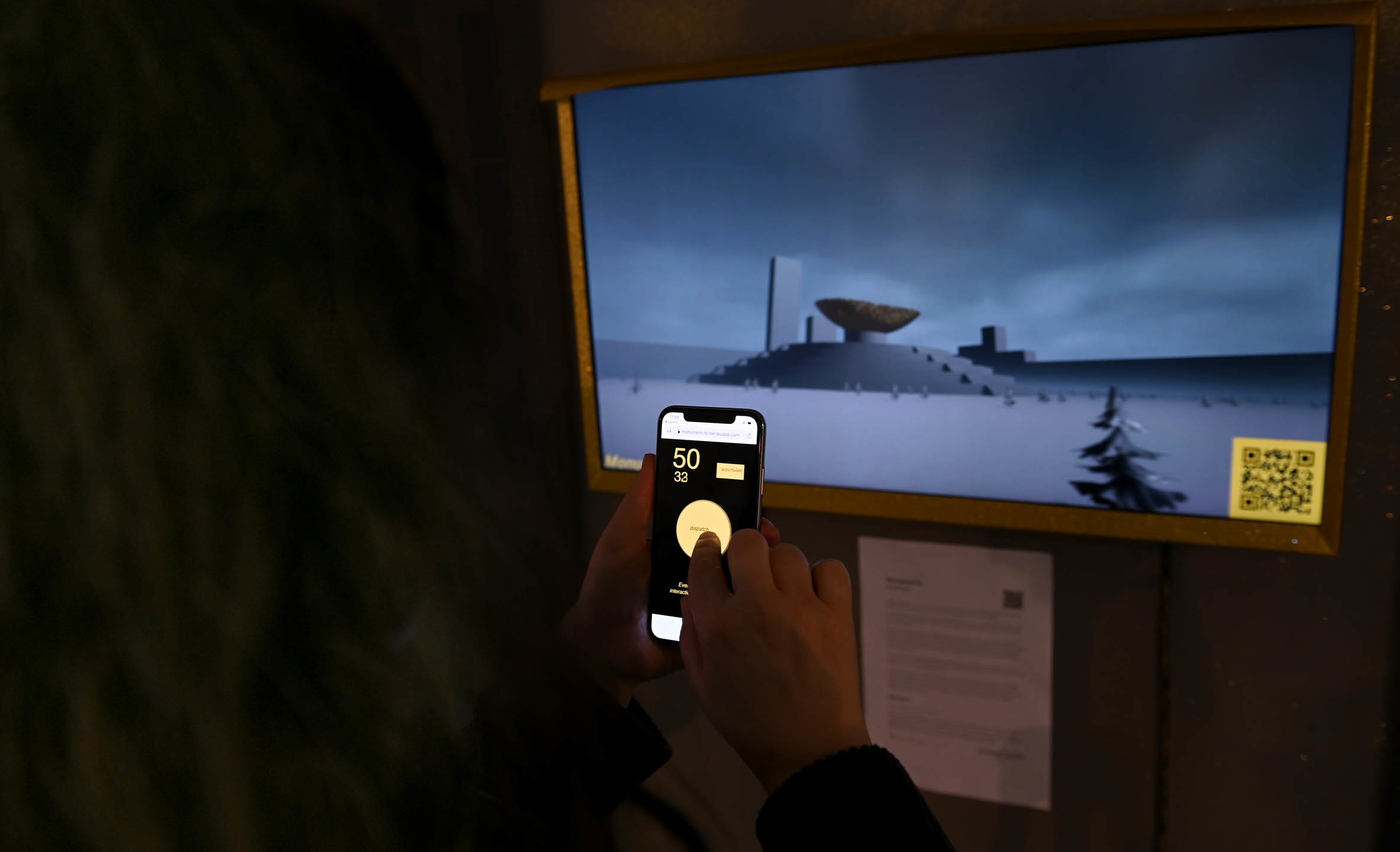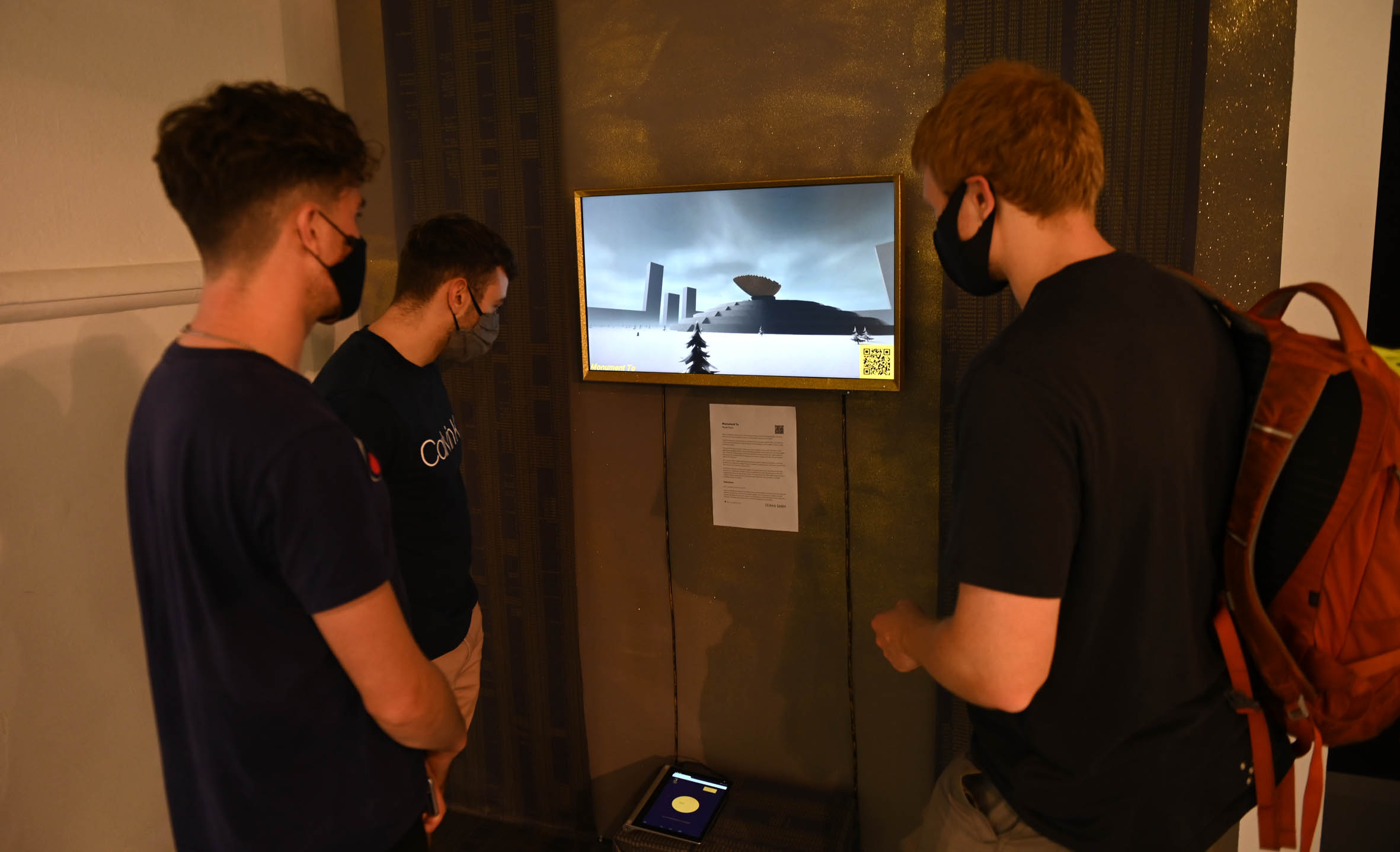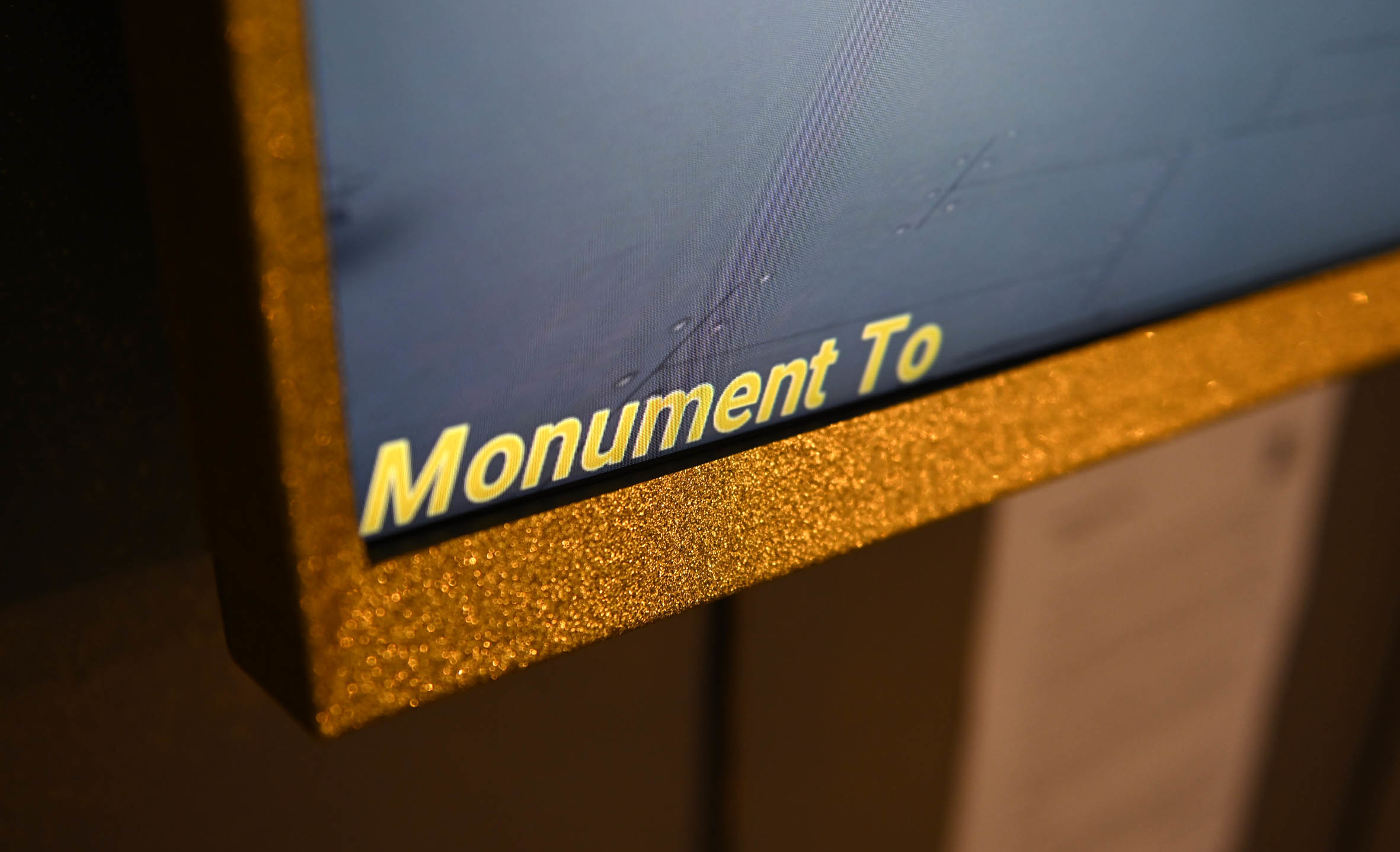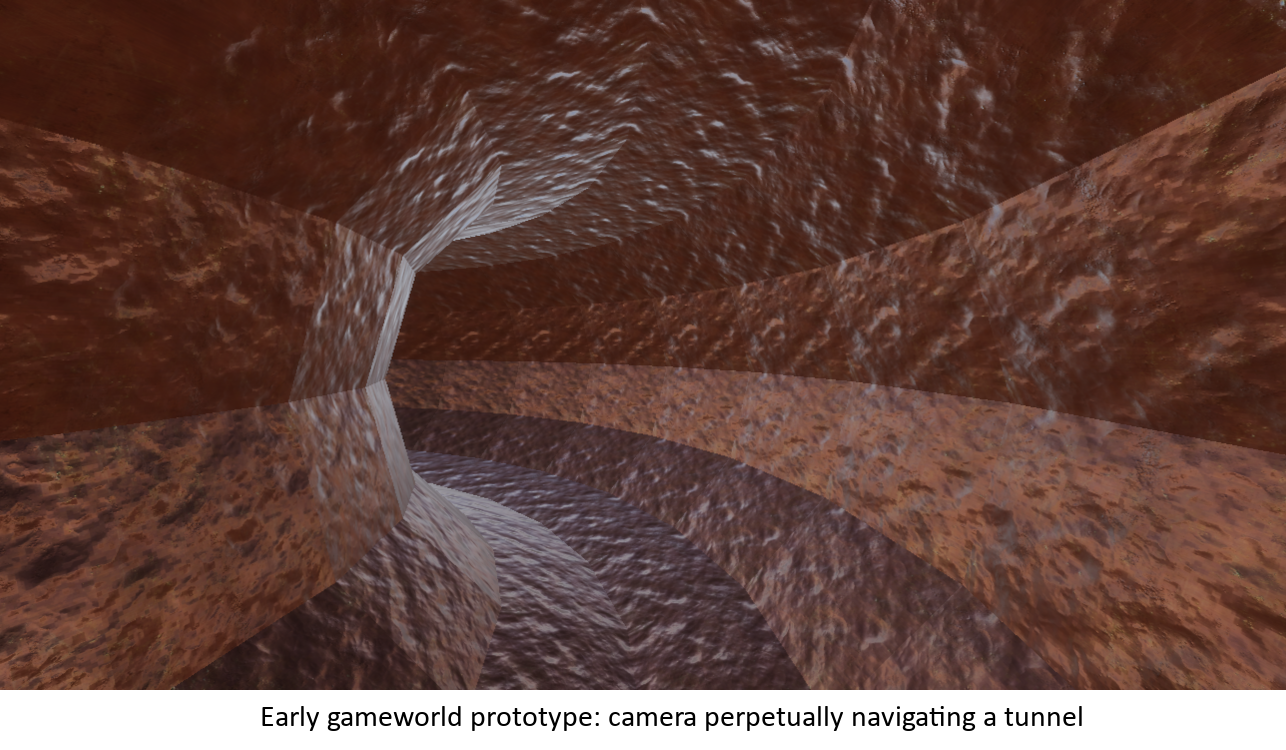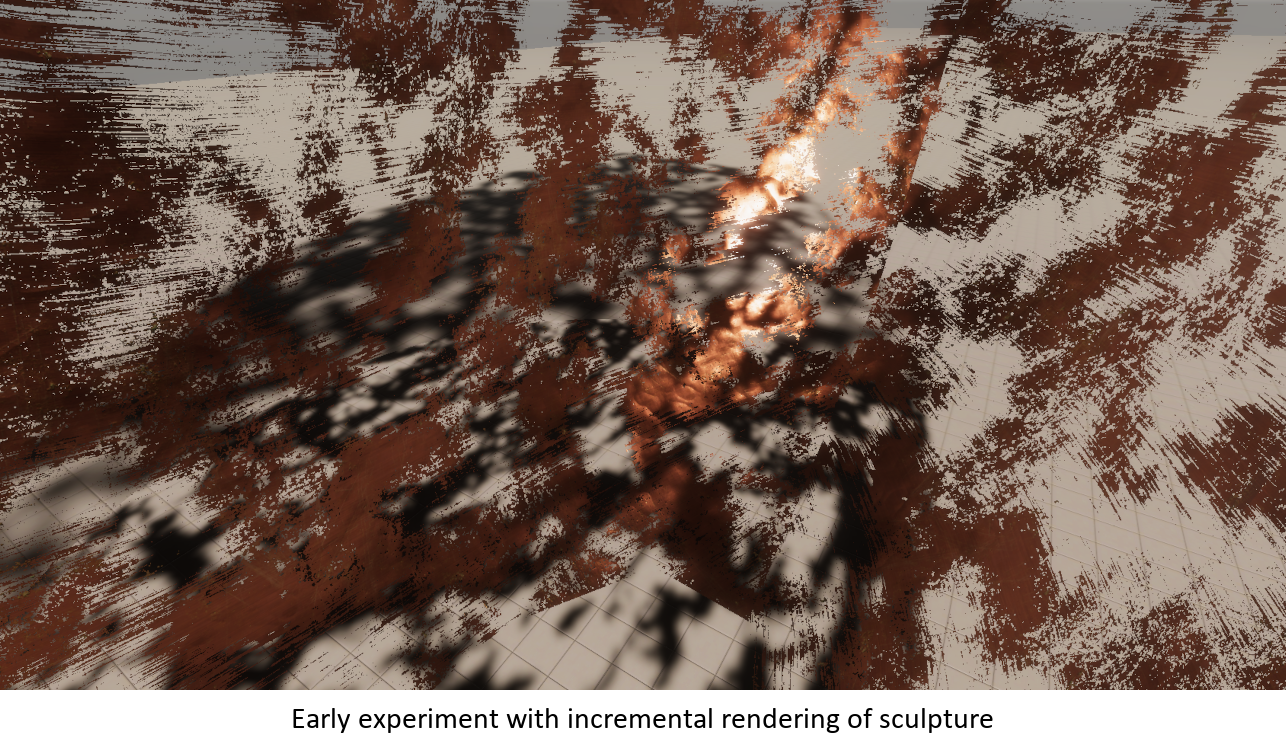Monument To
A monument-in-progress to the class of lounge labourers which we are all become.
Monument To is a perpetually progressing visualisation of collective digital actions, playfully presented as an incremental clicker game. Users are invited to reflect on the inseparability of digital work and leisure, and to roam with the ghosts of casualised value production.
produced by: Hazel Ryan
Introduction
Monument To is a gamelike exercise in collaborative world-building, towards a persistent visual record of usually throwaway acts of digital labour. The audience is encouraged to incrementally construct a digital sculpture in a ghostly landscape, giving material form to an accumulation of taps and clicks and treating this repetitive micro-work as a form of craftsmanship worth displaying on a pedestal.
Users connect to a hosted webapp inspired by incremental clicker games and perform a simple tapping interaction, put forward as an accumulation of numbers, which sends a message to the gameworld to add building blocks towards a sculpture. The work doesn’t rely on the sculpture being completed, but its current form builds towards a sculpture based on the raised-fist emoji, in a lighthearted monument to digital life and resistance. Each new user is also permanently represented as a ghostlike figure in the landscape, which gradually populates with vegetation along with the construction of the central monument.
The gameworld progresses permanently through interaction and it is down to the agency of the visitor to decide how much labour to contribute towards its construction. I hope the user might feel a connection to the piece through seeing their digital representation immortalised as part of the work.
I choose an opulent gold render for the digital sculpture, surrounded by an austere grey world, for a distinctive visual identity that supported the ideas of value production, craft and labour. I brought the glittering gold and grey contrasting theme into the exhibition space through decorations for a shrine-like feeling to the piece’s physical incarnation. Key- and mouse-log data gathered during my own work in creating the project is also made material as printouts, and flanks the screen to create an entangling of digital actions, both mine and those of the audience.
Concept and background research
I began with dual focuses on the concept of value, inspired by works such as {poem.py} by Pip Thornton and ClickMine by Sarah Friend, and on critiques of data visualisation, or the wider politics of data, following on from previous work. This developed into questioning what alienation of labour meant in a digital context, and I became interested in the emergent nature of digital labour, in the sense of postphenomenology: the texture of digital activity is mediated by the interface through which it is conducted.
In form, I was inspired by the format of the game Mountain by David O’Reilly, which is notable for its lack of distinct gameplay, existing as an idle simulation. The architectural leanings of Islands: Non-Places by Carl Burton were a visual inspiration along with their quiet, unhurried world-building. The writings and the consciously laborious games of Ian Bogost also informed my interest in exploring a work-leisure blur via the medium of work-like gameplay.
The starting point of the final piece was the idea that acts of work are endemic in every action and every moment mediated through digital platforms, with value creation being inseparable under capitalism from promises of digital leisure. I wanted to explore a ‘disalienation’ of labour via an exercise in retaining collective memory of these small acts of work.
The artefact of the monument became entwined for me with the idea of collective memory, and value. A construction process mediated by the audience brought into question agency and privileged histories: what do we choose to celebrate and visualise, and what is usually hidden? The grand monument to mundane actions is to me a subversion of dominant histories, where a monument can often be used by elites in “obliterating what is discomforting” (Bellentani and Panico, 2016). All monuments, including this, choose to remember certain histories and ignore others, but this one refuses to ignore our small acts of digital labour in a mattering or materalising.
Technical
Working in a gamelike space, I love the cross-format potential of the Unity 3D engine. Especially inspired by spending more time in virtual worlds built in game engines during lockdown (galleries as well as games), I knew that this software would provide a backbone for my project before the concept had been fully formed.
From the off, this needed to be a highly interactive piece: the blurred contemporary experience of digital leisure and labour embodied by engaging with the piece through repetitive, recorded interactions. That is, interaction with the piece was to take the form of digital labour in itself. I initially began creating a navigable 3D space, but while working on a faithful development process for a covid context, the physical form of the interaction became a key concern. I wanted to adapt away from a shared keyboard and mouse for safety and so I looked at using an app on the user’s own device as more appropriate controller. After initially developing a prototypical character/camera controller webapp, I re-evaluated through research and feedback, and decided instead to fully embrace the webapp format rather than trying to emulate regular game controls, which risked feeling awkward and arbitrary. I began to treat the 3D gamespace more as an animation/visualization with the webapp holding the interaction. The incremental clicker game, which I might consider the acme of casualised value production, appealed to my theoretical concept and I looked to distilled examples of incremental games, such as Blip Blop and Bogost’s Cow Clicker, in developing my own simple app.
When trying to send messages from the webapp, it took quite a lot of wrangling to get websocket communication working reliably with the Unity application client: I initially struggled to implement socket.io and turned to native websockets, but found the more rigid structure limiting, so finally returned to using socket.io via a slightly out-of-date Unity library which I adapted to work with my newer version of the engine.
One key question was whether to stage this as an on-site installation, or lean into its remote possibility via networked persistence. I made the decision that the installation made much more sense towards a meaningfully collective experience, and would allow me to emphasise the visual significance of the tangible monument.
The final stack of technologies in the project consists of:
- Key- and mouse-logger built in Python using the pynput library
- Webapp built using html and p5.js on the client-side, hosted on Heroku
- Server-side built in Node.js and using socket.io for communication between clients and server
- 3D world built in Unity using C# scripting, a socket.io library and custom assets
- Hidden laptop connected to LCD panel displaying 3D world; users encouraged to visit webapp via personal mobile device but sanitised tablet available as back-up
A small number of variables in Unity are used to control and save (via data serialization) the progress of the piece on each interaction. When the user accesses the page, socket.io sends a message via the Node.js server to the Unity client, received under the correct name and instantiating a ‘ghost’ figure in the landscape. When the user taps a particular button on the webapp, a socket.io message is sent under a different name, and when this is received by the Unity client, a gold building block is instantiated on an ordered vertex of a hidden mesh. Every so often (at random) this message also instantiates a tree at a random position in the landscape. The incremental rendering of the sculpture was challenging to implement – I tested out various different approaches, including using transparency and particle systems, before I solved this problem by use of simple objects spawning around mesh vertices.
Future development
I would like to attempt to realise this project in the globally persistent form I considered, i.e. as a WebGL Unity build accessible remotely as a single instance with the same point of progression for anyone who visited the site: this may be a simple analogue of the local scenario but experiments suggested it might pose more of a networking problem. The remote version might be developed for a different type of interaction – more of an integrated clicker game, as the process of connecting to a separate webapp would be clunky when taken away from the gallery context.
I would also prioritise audio in this type of build, ensuring it is an immersive experience accessed via a single platform. As per my experiments, audio would develop from simple background ambience towards increasingly complex melody in line with the progression of the monument. I wanted users to feel part of the space rather than request that they disappear into their own headphones for what would be a peripheral element of this incarnation, and out-loud sound would have conflicted with too many other nearby pieces, so I decided not to include the audio I had experimented with in this incarnation, but I would like to continue the development I began in Max/MSP, p5.js and Unity to find a smooth integration of reactive audio for a WebGL build.
Following many design iterations, I felt the simplicity of the final interaction and the clean design of the 3D world was the right choice for the gallery format, but I would also hope in future to find a clean way to integrate the keylogger data into the 3D world, since this formed an important underpinning to my process of a mattering of all digital interactions, including my own labour in creating the piece. If I had presented this data in the gameworld as well as in the physical space, this would have introduced an interesting circular aspect to the labour forming piece. I did experiment with various ways of representing this data but all of them felt like arbitrary data visualizations which detracted from the key concept, or else were incredibly complex for minimal impact: for instance, creating a terrain heightmap from a graph marking keystrokes over time (experiment shown here) or including a number of objects directly correlating to the number of these prior interactions recorded (with over a million keystrokes, this was not feasible).
In future iterations of the project, especially a permanently hosted web project, I would make sure that the piece was robust to any number of interactions: currently, there is an upper limit of the number of component pieces of the mesh forming the potential form of the structure: once these have been rendered, the gameworld is effectively complete, but I would improve this by adding unbounded behaviours such as gradual changes in the materials used in the 3D space, beyond that upper limit of interactions.
Self evaluation
In the end, I felt the piece had a successful presence as a coherent work within the gallery space: the decision to present it as an on-site project did benefit the work, highlighting the key features of the persistent, developing world and collective experience. Each new user was faced with a world populated by the echoes of previous experience, knowing that others had stood in the same spot and contributed effort, in a very direct chain of consequence which I believe would have had a different effect in a remote context.
I was especially pleased by the visual presentation of the piece, a quiet shrine-like space leaning heavily into the monument-in-progress designation, with an unsettling and luring air compounded by the slow pace of the camera and the fixed perspective. The muted opulence of the physical theme complimented the colour palette of the gameworld and the piece invited closer inspection to view the keylogger data, the matter of creation of the piece, flanking the digital monument. I considered a number of physical presentations including using paper print-outs or projections of the data, and the final iteration was a pleasing progression from my first thought of ‘a screen on a plinth’.
The piece was calibrated carefully through playtesting along with calculations and assumptions about how it might be interacted with in the space: I was keen to embrace the uncertainty as to how many people might put in how much work towards building the ‘monument’ over the course of the exhibition, but with the knowledge that it would be unlikely to be finished ‘too fast’. I possibly erred on the side of ‘too slow’ since the final possible form of the sculpture was only about halfway constructed by the end of the exhibition, but since the piece was intended to demand a lot of work towards construction, I wouldn’t say this was a failing.
The reliable persistence of the gameworld (the automatic save and load process), and the stability of the communication via socket.io, were key aspects underpinning the piece which I am proud of incorporating, especially in my first venture into web development. The 3D application could simply be exited, the laptop switched off, and when the piece was relaunched it would be in the state it was previously left in. This permanence made the piece very simple to administer as well as being important to my theoretical interest. Every intended message from the web client reached the Unity client with total reliability, which I felt was an achievement given my starting point of an obsolete socket.io library for Unity which I had to adapt for my version of the software.
My website (via https://tiny.cc/monument-to) had 100% uptime and was highly device-responsive, albeit a simple design. Providing a shortened URL and a dependable on-screen QR code incorporated through a UI element in Unity for website access were other touches that felt were successful, which made the piece easy to access in the gallery setting.
Development of user experience with the app could have been better polished: I did some testing but could have honed this element much more. The interactivity was designed to be slow-burning in line with the exploration of cumulative micro-actions, inviting time to be spent with the piece and rewarding repeat visits which would reveal a change in the system. Most users did embrace this understated experience, and I would not change the interaction to be more flashy as it would not be in the spirit of the project, but an important change I would make in a future iteration would be to highlight this more explicitly in an introductory page on the webapp served prior to the main app, reading something like, “Look closely to watch your actions become permanently reflected in the gameworld”. In hindsight I think the app could also have benefited from leaning further into the incremental clicker format, with upgrades and more complex goals: I hesitated on how heavily to embrace this aesthetic and went for a slightly more abstract and simple interface so that the app didn’t become the key point of interest, but I think now that more of an insidious game mechanic would have helped reinforce my concept.
References
Theory references
Barad, K., 2003. Posthumanist Performativity: Toward an Understanding of How Matter Comes to Matter. Signs: Journal of Women in Culture and Society, 28(3), pp.801-831.
Bellentani, F. and Panico, M., 2016. The meanings of monuments and memorials: toward a semiotic approach. Punctum. International Journal of Semiotics, 2(1), pp 28-46.
Bogost, I., 2019. Video Games Are Better Without Gameplay. [online] The Atlantic. Available at:
Brouwer, T., 2019. State Machines | Extracting Computerized Desires – A Review Of Clickmine. [online] Networkcultures.org. Available at:
Crary, J., 2013. 24/7. New York: Verso.
Forster, K.W., 1982. Monument/Memory and the Mortality of Architecture. Oppositions, 25, pp 2-19.
Ihde, D., 2009. Postphenomenology And Technoscience. Albany: State University of New York Press.
Krüger, S. and Johanssen, J., 2014. Alienation and Digital Labour—A Depth-Hermeneutic Inquiry into Online Commodification and the Unconscious. tripleC: Communication, Capitalism & Critique. Open Access Journal for a Global Sustainable Information Society, 12(2).
Tanz, J., 2011. The Curse Of Cow Clicker: How A Cheeky Satire Became A Videogame Hit. [online] WIRED. Available at:
http://www.davidoreilly.com/mountain
https://pipthornton.com/2016/06/12/poem-py-a-critique-of-linguistic-capitalism/
https://www.mosaiccorp.biz/blipblop
https://carlburton.itch.io/islands
Code/Resource references
Keylogger built beginning from tutorial from buildwithpython on YouTube; https://github.com/attreyabhatt/
Server and web client socket.io communication ("Server.js" and "Sketch.js") initially based on Andy Lomas's code for Summer Sessions 2020.
Socket.io library for Unity from Fabio Panettieri at https://assetstore.unity.com/packages/tools/network/socket-io-for-unity-21721
Unity assets: tree model, fist model, metal texture, sky texture are external resources.
































































